 W
WAnablepidae is a family of fishes which live in brackish and freshwater habitats from southern Mexico to southern South America. There are three genera with sixteen species: the four-eyed fishes, the onesided livebearers and the white-eye, Oxyzygonectes dovii. Fish of this family eat mostly insects and other invertebrates.
 W
WAnableps anableps, the largescale four-eyed fish is a species of four-eyed fish found in fresh and brackish waters of northern South America and Trinidad. This species grows to a length of 32 centimetres (13 in) TL. This fish can be found in the aquarium trade. The fish does not actually have four eyes, but instead each eye is split into two lobes by a horizontal band of tissue, with each lobe having its own pupil and separate vision. This allows the fish to see under and above the surface of the water at the same time.
 W
WAncistrini is a tribe of catfishes of the family Loricariidae. Most are restricted to tropical and subtropical South America, but there are also several genus in southern Central America.
 W
WApteronotus is a genus of weakly electric knifefish in the family Apteronotidae, distinguished by the presence of a tiny tail fin. This genus is restricted to tropical and subtropical South America and Panama where found in a wide range of freshwater habitats. They feed on small animals.
 W
WThe black-winged hatchetfish is a freshwater ray-finned fish native to South America.
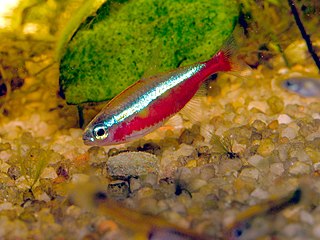 W
WThe cardinal tetra is a freshwater fish of the characin family of order Characiformes. It is native to the upper Orinoco and Negro Rivers in South America. Growing to about 3 cm (1.2 in) total length, the cardinal tetra has the striking iridescent blue line characteristic of the genus Paracheirodon laterally bisecting the fish, with the body below this line being vivid red in color, hence the name "cardinal tetra". The cardinal tetra's appearance is similar to that of the closely related neon tetra, with which it is often confused; the neon's red coloration extends only about halfway to the nose, and the neon's blue stripe is a less vibrant blue.
 W
WThe firewood catfish a species of South American pimelodid catfish, is the sole member of the genus Sorubimichthys. Known by locals along the Amazon Basin as peixe-lenha, the firewood catfish is so called because it is of little eating value and is often dried and used for firewood.
 W
WThe dusky millions fish, speckled mosquitofish or the one-spot livebearer is a species of fish native eastern and southern Brazil, northern Argentina, Uruguay and Paraguay. It has also been introduced to Australia, Malawi and New Zealand; primarily for mosquito control, but also as escapees from the aquarium trade. It has been reported as having adverse ecological effects in areas where it has been introduced. The females of this species grow to a total length of 6 centimetres (2.4 in), while males remain smaller.
 W
WThe glass knifefish is a weakly electric freshwater fish found across South America. It is marketed as an aquarium fish.
 W
WThe electric eel is a South American electric fish. Until 2019, it was classified as the only species in its genus. Despite the name, it is not an eel, but rather a knifefish.
 W
WEntomocorus is a genus of catfishes of the family Auchenipteridae.
 W
WFluviphylax is a genus of tiny poeciliids native to the Amazon Basin, Orinoco Basin and Oyapock Basin in South America.
 W
WThe four-eyed fishes are a genus, Anableps, of fishes in the family Anablepidae. They have eyes raised above the top of the head and divided in two different parts, so that they can see below and above the water surface at the same time.
 W
WGambusia is a large genus of viviparous fish in the family Poeciliidae. Gambusia contains over 40 species, most of which are principally found in freshwater habitats, though some species may also be found in brackish or saltwater habitats. The type species is the Cuban gambusia, G. punctata. The greatest species richness is in Mexico, Texas, and the Greater Antilles, but species are also found elsewhere in eastern and southern United States, The Bahamas, Central America, and Colombia. Gambusia species are often called topminnows or simply gambusias; they are also known as mosquitofish, which, however, refers more specifically to two species, G. affinis and G. holbrooki. These can be introduced into ponds to eat mosquito larvae. As a consequence, they have been introduced widely outside their native range, and frequently become invasive, threatening the local species. They are only occasionally kept in aquariums, due to their relative lack of color and the highly aggressive nature of the aforementioned mosquitofish species.
 W
WGeophagus altifrons is a freshwater eartheater cichlid fish native to the Amazon River Basin, Brazil.
 W
WThe gold tetra is a species of small freshwater fish in the family Characidae native to lowland South America, where they are abundant in coastal floodplains. Their name comes from a powdery golden tint on their body that is thought to be caused by internal parasites. Gold tetras are peaceful, hardy, schooling community fish. Gold tetras have been successfully bred in captivity.
 W
WThe green neon tetra is a freshwater fish of the family Characidae of order Characiformes. It is native to the upper Orinoco and Negro Rivers in South America.
 W
WHelogenes is a genus of whale catfish found in tropical South America.
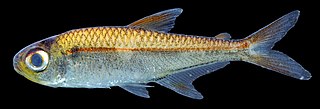 W
WHemigrammus elegans is a species of freshwater fish in the family Characidae native to South America. The type locality is Óbidos, Amazon River, Brazil.
 W
WHydrolycus is a genus of large dogtooth characins from tropical South America, where found in the Amazon and Orinoco basins, as well as rivers of the Guianas. The genus includes the largest dogtooth characins, reaching up to 1.17 m (3.8 ft) in length. They have long, pointed teeth used for spearing their prey, generally smaller fish. In a study of the stomachs of 45 individuals, most were empty, but among the remaining the prey fish were 15–50% of the length Hydrolycus itself.
 W
WMesonauta, the flag cichlids, is a small genus of cichlids native to the Amazon, Orinoco, Essequibo, Paraná and Paraguay basins in South America. Mesonauta is included in the subfamily Cichlasomatinae. They occur in various freshwater habitats such as streams and lakes, especially in areas with little water movement and aquatic vegetation. They are generally found in small groups that stay near the water surface. To avoid predators, adults may jump out of the water and juveniles mimic leaves.
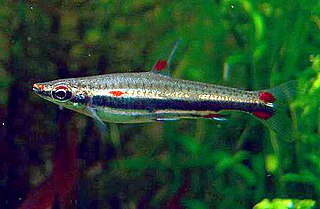 W
WNannostomus trifasciatus,, commonly known as the three-lined or three-stripe pencilfish, is a freshwater species of fish belonging to the characin family Lebiasinidae. They are popular in the aquarium trade due to their small size, beautiful color pattern, and relative hardiness.
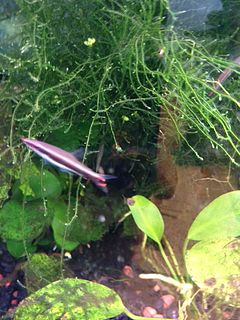 W
WNannostomus unifasciatus,, commonly known as the one-lined pencilfish, is a freshwater species of fish belonging to the genus Nannostomus in the characin family Lebiasinidae. They are popular in the aquarium trade due to their small size, beautiful color pattern, unique swimming posture and relative hardiness. With its long, pencil-shaped profile, its single jet black stripe reminiscent of the graphite core of a pencil, and its eraser-colored caudal fin, this is the species for which the popular name, 'pencilfish', was first coined in the 1920s, later to be applied to all the species of the genus Nannostomus.
 W
WNeoheterandria is a genus of poeciliids native to Panama and Colombia.
 W
WJenynsia is a genus of freshwater fishes in the family Anablepidae. Like Anableps species, they are onesided livebearers: some sources indicate that they only mate on one side, right-"handed" males with left-"handed" females and vice versa. However other sources dispute this. These South American fish are viviparous.
 W
WThe oscar is a species of fish from the cichlid family known under a variety of common names, including tiger oscar, velvet cichlid, and marble cichlid. In tropical South America, where the species naturally resides, A. ocellatus specimens are often found for sale as a food fish in the local markets. The fish has been introduced to other areas, including India, China, Australia, and the United States. It is considered a popular aquarium fish in Europe and the U.S.
 W
WOtocinclus arnoldi is a species of armoured catfish native to South America, where it occurs in the lower río Paraná drainage, in the lower and middle rio Uruguai and in the río de La Plata. This species reaches a maximum length of 4.8 centimetres (1.9 in) (SL).
 W
WThe payara, Hydrolycus scomberoides, is a species of dogtooth tetra. This predatory fish is found in the Amazon Basin in tropical South America. It was the first of four species to be described in the genus Hydrolycus.
 W
WNannostomus,, is a genus of fish belonging to the characin family Lebiasinidae. All of the species in this genus are known as pencil fish or pencilfish, a popular name that was first only applied to two species in the 1920s, Nannostomus unifasciatus and Nannostomus eques, but by the late 1950s would come to be applied to all members of the genus. Several of the species have become popular aquarium fish due to their attractive coloration, unique shape, and interesting demeanor.
 W
WPimelodella is a genus of three-barbeled catfishes.
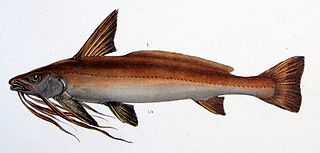 W
WPinirampus pirinampu is a species of catfish of the family Pimelodidae. P. pirinampu is also known as the flatwhiskered catfish.
 W
WThe Poeciliidae are a family of freshwater fishes of the order Cyprinodontiformes, the tooth-carps, and include well-known live-bearing aquarium fish, such as the guppy, molly, platy, and swordtail. The original distribution of the family was the southeastern United States to north of Río de la Plata, Argentina, and Africa, including Madagascar. However, due to release of aquarium specimens and the widespread use of species of the genera Poecilia and Gambusia for mosquito control, poeciliids can today be found in all tropical and subtropical areas of the world. In addition, Poecilia and Gambusia specimens have been identified in hot springs pools as far north as Banff, Alberta.
 W
WThe silver arowana is a South American freshwater bony fish of the family Osteoglossidae. Silver arowanas are sometimes kept in aquariums, but they are predatory and require a very large tank.
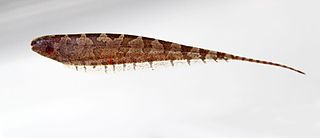 W
WSteatogenys is a genus of gymnotiform knifefishes found in the Amazon, Orinoco and Essequibo river basins in tropical South America. The widespread and common S. elegans is found in a wide range of habitats, from the shallow essentially static waters such as floodplain lakes to fast-flowing rivers as deep as 50 m (160 ft). The two remaining species are less common and widespread, with A. duidae found mainly in small streams running through terra firme forests and S. ocellatus among submerged roots and branches in static or slow-flowing blackwater habitats. All three are regularly found among vegetation in floating meadows, a habitat that often contains little oxygen, but they are well-adapted to this.
 W
WThe tambaqui is a large species of freshwater fish in the family Serrasalmidae. It is native to tropical South America, but kept in aquaculture and introduced elsewhere. It is also known by the names black pacu, black-finned pacu, giant pacu, cachama, gamitana, and sometimes as pacu.
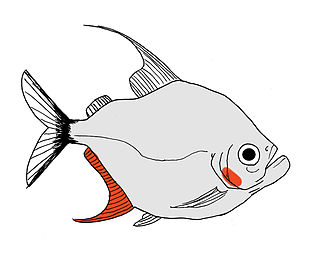 W
WThe wimple piranha, Catoprion mento, is a specialized, South American species of piranha that feeds on fish scales. There is debates over whether or not this species is considered a true piranha. If it was considered a true piranha, then it would be the smallest species in the world
 W
WZungaro is a genus of long-whiskered catfishes native to South America, with two recognized species as of 2018:Zungaro jahu (Ihering, 1898) Zungaro zungaro (Humboldt, 1821)